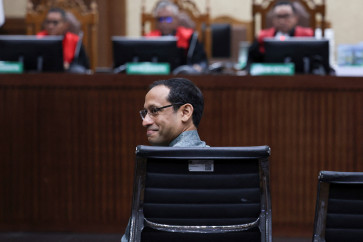Popular Reads
Top Results
Can't find what you're looking for?
View all search resultsPopular Reads
Top Results
Can't find what you're looking for?
View all search resultsGovt innovates to halt coastal erosion
As the country is losing coastal areas to erosion, the government of the world’s largest archipelagic nation is working to stop it from getting worse, using both soft innovations and the construction of concrete-based structures
Change text size
Gift Premium Articles
to Anyone
A
s the country is losing coastal areas to erosion, the government of the world’s largest archipelagic nation is working to stop it from getting worse, using both soft innovations and the construction of concrete-based structures.
Coastal erosion is a natural phenomenon that occurs in coastal areas where land along a coastline is lost to the ocean usually because of wave and wind action. In ideal conditions, another process known as accretion should replace the displaced land by the same amount of sediment eroded from other areas.
Lately, the erosion across the country has been worsening because of the rampant cutting of mangrove trees, which serve as natural protection for coastal areas. The plant is also known for its role in assisting the accretion process by trapping sediment; therefore, its absence has been preventing sedimentation from occurring.
Acknowledging that replanting mangroves would take a long time to succeed, the Maritime Affairs and Fisheries Ministry is working on several innovations to recover the eroded coastlines.
“We try to recreate the mangrove’s function of trapping sediment by erecting what we call ‘hybrid engineering’ structures,” the head of the Maritime Affairs and Fishery Ministry’s coastal disaster mitigation section, Abdul Muhari, told The Jakarta Post.
The permeable structure — two parallel bamboo fences with the space between them filled by twigs — works as a sediment trap to catch mud brought by the tide, rather than as a breakwater to hold off waves from hitting the beach. It is installed in the water several meters from the coastline.
“This is in line with the ministry’s principle of building with nature: We use local materials and use a natural phenomenon to recover the land,” Abdul said.
The ministry has constructed a total of 29 kilometers of the hybrid structures in 14 regencies since 2017.
Most of the regions are located along the northern coast of Java Island, as the area is deemed to be affected the most by the erosion. Only this year, the ministry started to build such structures in at least three regencies outside the nation’s most populous island: Bombana in Southeast Sulawesi, Banggai in Central Sulawesi and East Lombok in West Nusa Tenggara.
According to a report issued by the ministry, the structure has succeeded in catching sediment on eroded shoreline. In East Java’s Gresik, accretion has occurred, retaining 0.1 to 0.5 millimeters of sediment in just three months after the erection of the hybrid structure.
The progress had attracted interest from several internal institutions, leading them to replicate the approach in South and Southeast Asia, as it is seen as a measure to curb climate change.
Such a plan, however, might be hindered by locals’ activities on the rehabilitated shorelines. In Gresik, for example, several residents used hand tractors to hunt for red crabs on the newly formed lands, while unfortunately running over small mangrove seedlings.
In other places, residents claimed their ownership on the rehabilitated land because they had a land certificates initially designated for the land that had eroded away. Once they claimed the land, they would start to build fish ponds on it, potentially harming the coastal area once again.
Abdul added that the maintenance of the structures was also hindered by the lack of attention from regional administrations. “The central government’s effort should be a trigger for action. However, it only ended in vain in most cases,” he said.
The Bandung Institute of Technology’s Armi Susandi said coastal recovery measures should become a responsibility for every relevant stakeholder, including regional administrations and local educational institutions.
“Vocational schools or local universities can learn a lot from such measures and potentially develop them further in the future,” Armi said.
In the meantime, the Public Works and Public Housing Ministry has the authority to construct concrete-based structures to prevent further coastal erosion in several places. The structure ranges from seawalls to breakwaters.
While such structures could produce faster results for protecting beaches compared to their hybrid counterparts, their construction would be more expensive, said the head of the ministry’s beach and riverbed planning division, Bambang Heri. Between 2015 and 2019, the ministry had built 157 km of coastal protection structures around the country, including on Miangas Island in North Sulawesi and Anambas Island in Riau Islands.
“Therefore, we are prioritizing Java Island’s northern coast, which suffers the most from the phenomenon, coasts near the borders with neighboring countries, and the outermost islands,” Bambang said.










